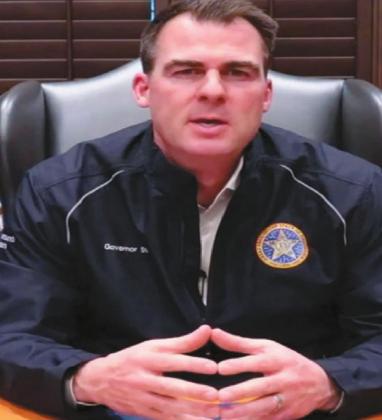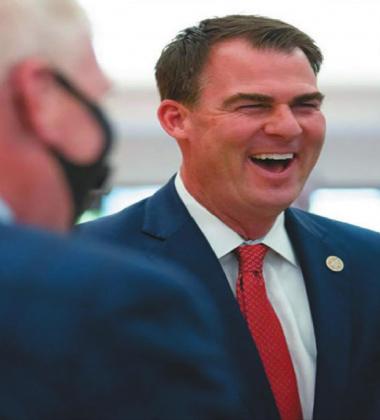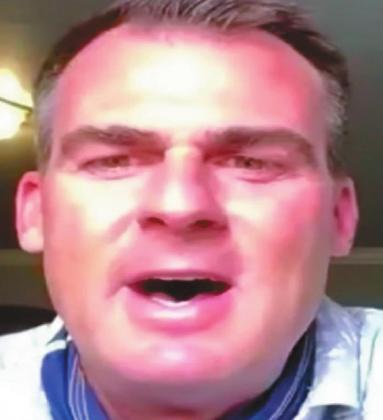Photographs and screenshots depict Gov. Kevin Stitt throughout the pandemic, from March through November. Early in the pandemic, Stitt was rarely seen with a mask. He showed up at press conferences and events, like a tour of a shopping mall reopening in May, wearing no mask. In June, he announced via video stream that he had tested positive for COVID-19. Later that month at a press conference, he encouraged Oklahomans to wear a mask and pulled his neck buff over his face. He then removed it and continued speaking. Since then, he often appears in public with a mask, though it is not always covering his face. (Oklahoma Watch)
A masked Gov. Kevin Stitt walked into a roomful of masked reporters at the Oklahoma Capitol, sat down at the head of a conference table and removed his mask.
Flanked by his health commissioner and a hospital surge plan advisor, who both wore masks, Stitt was there to answer questions about the state’s coronavirus response. What he did in those first moments spoke volumes: a disjointed message on masks.
Nationwide, 37 states have a statewide mask mandate, with Iowa the latest state to put one into effect. In a sevenstate region that includes Oklahoma, only it and Missouri are without statewide mask mandates.
To be fair, Stitt isn’t antimask. He’s recommended mask wearing, along with social distancing and washing hands, in his public health messages around the coronavirus since the summer. Stitt said a statewide mask mandate would be hard to enforce and it should be a decision left to local leaders.
Eight months into the pandemic, masks remain a flashpoint. That’s flummoxed public health officials, who thought a relatively minor inconvenience to inhibit the spread of an airborne virus would not become a political talking point. Elected leaders in some cities continue to grapple with the right balance of promoting a key public health message without alienating a minority of residents who downplay the virus.
Stitt has been an inconsistent messenger on masks since the state’s first confirmed coronavirus case in March. The governor rarely showed up to events wearing a mask in April and May, when the state was focused on its reopening plans after a brief shutdown. And at an indoor rally in Tulsa for President Donald Trump in June, a maskless Stitt sat on stage with other elected officials, most of whom were also not wearing masks. In recent months, Stitt appears at public events wearing a mask, only to quickly take it off if he’s speaking.
Medical and public health leaders have consistently called for mask mandates, including the Oklahoma State Medical Association. A statewide mask mandate would give political cover to local officials who want people in their communities to wear masks but lack the political will or the votes to get it done. The weekly reports from the White House’s coronavirus task force have recommended several times that Oklahoma institute a statewide mask mandate.
Still, Oklahomans are weary of the pandemic and some object to what they think is fear-mongering by maskmandate advocates. The latest virus surge is happening in states with and without statewide mask mandates. Stitt and his advisors prefer to focus on mask participation than any mandate, and Stitt has grown weary of being asked the question at press conferences.
“Oklahoma has been fully reopened for six months,” Stitt said at a Nov. 19 press briefing. “We’re seeing our cases go up and not as fast as some of these shutdown states. It’s a virus. If I could wave my magic wand to make it totally disappear in Oklahoma, I would do it. But again, I don’t think it’s about magic words. I think it’s about compliance and social distancing and those types of things like washing your hands and staying at home if you’re exposed.”
In the meantime, teachers and parents have been whipsawed by school district decisions on virtual, in-person or blended schedules. Oklahoma City Public Schools returned briefly to in-person instruction earlier this month, only to go back to virtual classes after cases spiked in the county. Stitt said he’d like all public schools to return to in-person instruction after the holidays, but a deadlocked State Board of Education has refused to mandate masks in schools.
Stitt did take a tiny step tward a mask mandate when he announced on Nov. 16 that all employees of executive agencies should wear masks in state office buildings. Those requirements on 33,000 state employees came as part of a package of statewide restrictions on bar and restaurant hours and social distancing requirements for indoor dining.
Broken Arrow City Council member Debra Wimpee, left, listens as member Christi Gillespie, right, talks during a Nov. 17 meeting during which council members and residents discussed a possible mask mandate. (Rip Stell/For Oklahoma Watch)
Seven of the top 10 most populated cities in Oklahoma have local mask mandates in place. That represents almost 40% of the state’s population. Owasso, a Tulsa suburb, became the latest city to vote for a mask mandate. But a mask mandate in Muskogee failed this month in a 4-3 vote. In Broken Arrow, the state’s fourth-largest city with more than 110,000 people, the mayor said he doesn’t have the votes to push through a mask mandate.
“I do not see this council passing a mask ordinance at this time,” Mayor Craig Thurmond said in a Nov. 13 video on the city’s Facebook site.
Broken Arrow council members discussed the city’s latest virus numbers at a meeting on Nov. 18. Just one member supported a mask ordinance, and two members spent most of their time speaking against masks and downplaying coronavirus risks.
Tulsa Mayor G.T. Bynum wants a statewide mask mandate, largely because other large cities in Tulsa County, like Broken Arrow, haven’t matched Tulsa’s mask mandate. That’s made it more difficult to slow the spread as residents move between cities to shop, eat and work.
“The argument has been made, ‘Well you know we really want to encourage people and support personal responsibility.’ My response to that is: Every law we have would be fine if people were personally responsible. But at this point, we’ve reached a point where we need action,” Bynum said in a Nov. 12 appearance on MSNBC.
Oklahoma City Mayor David Holt said he’s not been shy about the need for mask mandates.
“How I feel about mask requirements should be obvious by the fact that I lead a city that has one and I was very supportive of it. So I am a champion for them,” Holt said on Nov. 19. “They clearly reduce the transmission. I am not the governor of Oklahoma. I can’t make it happen for anyone but the people of my city.”
Holt praised Oklahoma City metro-area cities that have passed their own mask mandates. Moore, the state’s 7thlargest city and sandwiched between Oklahoma City and Norman, has not passed a local mask mandate. Holt said if the state is unwilling to put in a statewide mandate, a regional approach might work better.
“We would certainly welcome that because it would bring continuity across all of our jurisdictions in central Oklahoma; it would certainly simplify the process,” Holt said. “I mean, we’ve got like two dozen cities here in the Oklahoma City metro. All of them have to go through these very complicated and time-consuming processes to institute their mask requirements and renew their mask requirements. And so we would certainly welcome a simplification of that.”
Nearby states with statewide mask mandates have shown flexibility. Texas allows counties to opt out of the state’s mandate if their infections are lower than certain thresholds. Kansas allowed counties to opt out of its statewide mandate in July. Gov. Laura Kelly, a Democrat, renewed her executive order this week but told counties they must either pass their own tailored mask mandates within a week or use the “one-size-fits-all” policy adopted by the state.
Even in cities with mask mandates, compliance remains an issue. It’s largely been left to private business to enforce, much like the signs on doors for guns or the older ones for “No shirt. No shoes. No service.” There have been sporadic reports of some retail employees being threatened by customers, like what happened in Stillwater after an emergency mask requirement went into effect in May. The council later voted in July for a city ordinance for masks.
Social media has been rife with examples of residents in mask-mandate cities flouting the rules. A widely circulated picture of a concert at Victory Church in Tulsa drew rebukes from Bynum and Bruce Dart, executive director of the Tulsa Health Department. In Norman, Mayor Breea Clark asked police to investigate after pictures of large crowds of largely maskless college students wating outside bars went viral on the Friday evening before the Bedlam football game between the University of Oklahoma and Oklahoma State University.
At OKC Outlets in Oklahoma City in the week before Thanksgiving, shoppers generally complied with signs at stores for mask wearing. Many took masks off when they came outside or at least pushed them down a bit for air. Then they’d put them on or pull them back up when they visited another store.
Ayla Ratliff and CJ Burroughs of Harrah held hands while strolling through a breezeway at the outlet mall. The pair wore bandanas around their necks but said they don’t pull them over their faces unless store employees require it.
“It’s hard to breathe, and it’s uncomfortable,” Burroughs said.
Epidemiologists at the Oklahoma State Department of Health have published statistics showing the virus appears to spread less in cities whose residents are wearing masks compared to cities with no mask mandates or ordinances. Meanwhile, a recent snapshot of insurance claims and hospitalization data collected by the MyHealth Access Network showed about two-thirds of COVID-19 hospitalizations came from nonmasking cities, compared to one-third of admissions from masking cities.
Beyond the science, a mask is the most visual sign that a person is taking the spread of the virus seriously. But shame is rarely a successful pitch in public health messaging. Stitt himself said in July he doesn’t want to be a “mask shamer.” That was just days before he announced that he tested positive for the coronavirus, becoming the first governor in the country to be infected.
Early in the pandemic, when COVID-19 hit hardest in states like New York and Louisiana, many people made up their minds on how they would respond. And the message then was to conserve medical-grade masks because they were in short supply. In states and counties where the virus hadn’t yet made an appearance, people generally went about their normal lives. Much of the public health messaging nationally came from the White House and its coronavirus task force as Trump sidelined leaders from the Centers for Disease Control and Prevention.
Now, as cases explode again nationwide, getting people to rethink their personal responsibility is a tall order. With hospitalizations and cases both rising rapidly this month, the Stitt administration pushed doctors to the forefront of its mask messaging effort. Doctors, infectious disease specialists and chief medical officers from central Oklahoma hospitals earlier this month implored residents to wear masks.
“Wearing a mask is not a sign of weakness or fear,” said Dr. Julie Watson, chief medical officer for Integris Health. “It’s not a political statement. It’s an outward symbol that says, ‘I am contributing,’ ‘I am willing to do what it takes to help.’ And it’s also not about a mandate. The governor nor the government should have to tell us to do the right thing. We know better now, so we need to do better.”
Leaders at the Oklahoma State Department of Health have consistently said any mask mandate should be up to the governor. Despite being asked on several occasions, Interim Health Commissioner Dr. Lance Frye and State Epidemiologist Jared Taylor haven’t publicly acknowledged they recommended Stitt issue a statewide mask order.
“We’ve had some information presented to us that looked at several different mitigation factors, and mask mandates was one that made the least difference,” Frye said during a Nov. 9 media briefing. “I’m not saying masks don’t work. It was the mandate; it wasn’t the wearing. Compliance is what we need, and that’s what works in the state.”
In a nod to government skepticism dating back to statehood, Frye said some Oklahomans have a strong anti-government impulse.
“I’ve had multiple people come up to me and tell me, ‘Hey, I’ll wear a mask, but don’t tell me I have to wear a mask. I’m not going to do it,’” Frye said. “Do we have independent people in the state of Oklahoma that believe in their freedom so much that they’ll do the opposite you tell them to do? My answer is absolutely, we do have those people in Oklahoma.”
Holt, who pointed to earlier polls showing large majorities of Oklahomans favor mask mandates, said the mask conversation has been driven by a small, but vocal, minority.
“The vast majority of our residents support these requirements,” Holt said. “I think what happens is we get fatigued. I may not be speaking to the 20% of residents who don’t want to do anything for COVID-19, but we don’t really need them to get these numbers down. We need that group in the middle that did take precautions at an earlier time. I think we need a unified voice across all levels of government and across the community.”



